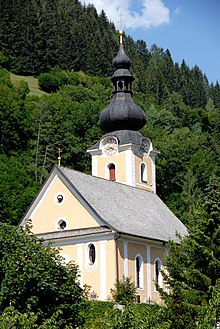Bad Kleinkirchheim
Bad Kleinkirchheim | ||
|---|---|---|
 Bad Kleinkirchheim in December 2005 | ||
|
Postal code 9546 | ||
| Area code | 04240 | |
| Vehicle registration | SP | |
| Website | bad-kleinkirchheim.gv.at | |
Bad Kleinkirchheim is a municipality and
Until the middle of the 20th century, agriculture was the dominant focus, but it is now a renowned spa and ski resort. Although records show people appreciating the area as a recreation area as early as the 11th century, and the first bathing guests arriving in the 17th century, it was only in the last few decades that Bad Kleinkirchheim began to move away from agriculture and focus on its potential for tourism.
Geography

Location
Bad Kleinkirchheim is at an average elevation of 1,087 m (3,566 ft) in a 5 km (3 mi) stretch of a glacial trough valley in the Gurktal Alps (Nock Mountains), between the Millstätter See and the upper Gurk River. The populated section lies between 980 m (3,215 ft) and 1,380 m (4,528 ft), and the highest point in the area is the peak of the Klomnock, at 2,331 m (7,648 ft). North of Kleinkirchheim and St. Oswald, part of the Nockberge National Park is within the area’s boundaries.
To the north and south of the valley, the hills rise relatively steeply to an elevation of about 2,000 m (6,600 ft), so that the only way in and out is by the B88 road which links the area to Radenthein in the west and Reichenau in the east. Bad Kleinkirchheim also borders Krems in the northwest and Feld am See to the southwest.
Municipal arrangement
Bad Kleinkirchheim is divided into 3
Kleinkirchheim Sankt Oswald Zirkitzen Aigen (population: 57) Sankt Oswald (168) Rottenstein (99) Bach (302) Staudach (167) Zirkitzen (418) Kleinkirchheim (357) Obertschern (127) Unterschern (168)
History

The remote and densely forested valley apparently was not settled in Roman times, when the area became part of the Noricum province in 15 BC. From about 600, Alpine Slavs migrated up the Drava and its tributary valleys, followed by Bavarian settlers from the mid 8th century onwards. In the early 9th century, the region passed under Carolingian suzerainty. Part of the Imperial Duchy of Carinthia from 976, the Kleinkirchheim estates were held by the Bavarian Aribonid dynasty.
In a document dated 5 July 1166, in which Archbishop Conrad II of
In 1469 Millstatt Abbey was dissolved and its estates passed to the Knightly Order of Saint George, established by Emperor
During the
Bad Kleinkirchheim was shortly ruled within the French Illyrian Provinces during the Napoleonic Wars, but returned to the Austrian Empire in 1816. The Revolutions of 1848 also affected the area, as farmers (which then made up most of the town's population) got more rights.
Finally, in 1973, Bad Kleinkirchheim officially had the "Bad" (bath, spa) attached to its name, Kleinkirchheim, a reference to the popular hot spring.
Population
| Year | Pop. | ±% |
|---|---|---|
| 1869 | 915 | — |
| 1880 | 968 | +5.8% |
| 1890 | 970 | +0.2% |
| 1900 | 968 | −0.2% |
| 1910 | 1,062 | +9.7% |
| 1923 | 944 | −11.1% |
| 1934 | 1,055 | +11.8% |
| 1939 | 43 | −95.9% |
| 1951 | 1,268 | +2848.8% |
| 1961 | 1,352 | +6.6% |
| 1971 | 1,731 | +28.0% |
| 1981 | 1,783 | +3.0% |
| 1991 | 1,889 | +5.9% |
| 2001 | 1,863 | −1.4% |
93.4% of the inhabitants of Bad Kleinkirchheim are Austrian by nationality. The largest portion of the foreign population comes from South-East Europe (
, 3.5% are without religious confession.Buildings
This town is most famous for its church, built circa 1492. There are also many farms and mills.
Sports
The town is known for its ski resorts, offering skiable slopes of 185 km, as well as 16 km of tracks for cross-country skiing. The
Besides
.Politics
The Mayor of the town is Matthias Krenn (
References
- ^ "Dauersiedlungsraum der Gemeinden Politischen Bezirke und Bundesländer - Gebietsstand 1.1.2018". Statistics Austria. Retrieved 10 March 2019.
- ^ "Einwohnerzahl 1.1.2018 nach Gemeinden mit Status, Gebietsstand 1.1.2018". Statistics Austria. Retrieved 9 March 2019.
- ^ Katastralgemeinden of Austria in 2001:Statistik Austria
